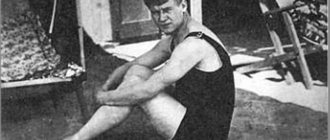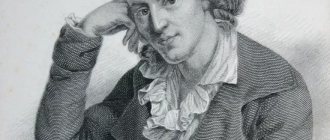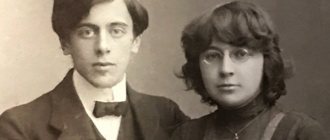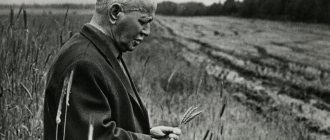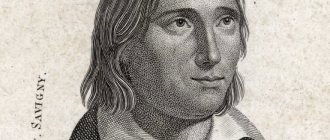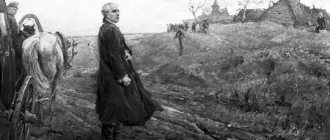March 28, 1868 – June 18, 1936 (68 years old)
4.5
Average rating: 4.5
Total ratings received: 8638.
Maxim Gorky (1868–1936) - famous Russian writer and playwright, author of works on revolutionary themes, founder of socialist realism, nominee for the Nobel Prize in Literature. He spent many years in exile.
The material was prepared jointly with a teacher of the highest category, Kuchmina Nadezhda Vladimirovna.
Experience as a teacher of Russian language and literature - 27 years.
early years
Born on March 16 (28), 1868 in Nizhny Novgorod in a poor family of a carpenter. The real name of Maxim Gorky is Alexey Maksimovich Peshkov. His parents died early, and little Alexey remained to live with his grandfather. His grandmother became a mentor in literature, who led her grandson into the world of folk poetry. He wrote about her briefly, but with great tenderness: “In those years, I was filled with my grandmother’s poems, like a beehive with honey; It seems that I was thinking in the forms of her poems.”
Gorky's childhood was spent in harsh, difficult conditions. From an early age, the future writer was forced to do part-time work, earning a living by whatever he could.
Alexey Maksimovich Peshkov
The real name of Maxim Gorky is Alexey Maksimovich Peshkov. The pseudonym “Maxim Gorky,” by which most readers know him, first appeared on September 12, 1892 in the Tiflis newspaper “Caucasus” in the caption to the story “Makar Chudra.”
An interesting fact is that Gorky had another pseudonym with which he sometimes signed his works: Yehudiel Chlamida.
Special features of Maxim Gorky
Training and beginning of literary activity
In Gorky's life, only two years were devoted to studying at the Nizhny Novgorod School. Then, due to poverty, he went to work, but was constantly engaged in self-education. 1887 was one of the most difficult years in Gorky's biography. Due to the troubles that beset him, he tried to commit suicide, but nevertheless survived.
Traveling around the country, Gorky propagated the revolution, for which he was taken under police surveillance and then arrested for the first time in 1888.
Gorky's first published story, "Makar Chudra", was published in 1892. Then his essays in two volumes, “Essays and Stories,” published in 1898, brought fame to the writer.
In 1900–1901 he wrote the novel “Three”, met Anton Chekhov and Leo Tolstoy.
In 1902, he was awarded the title of member of the Imperial Academy of Sciences, but by order of Nicholas II it was soon invalidated.
Gorky's famous works include the story "Old Woman Izergil" (1895), the plays "Philistines" (1901) and "At the Lower Depths" (1902), the stories "Childhood" (1913–1914) and "In people" (1915-1916), the novel "The Life of Klim Samgin" (1925-1936), which the author never finished, and many cycles of stories.
Gorky also wrote fairy tales for children. Among them are “The Tale of Ivanushka the Fool”, “Sparrow”, “Samovar”, “Tales of Italy” and others. Remembering his difficult childhood, Gorky paid special attention to children, organized holidays for children from poor families, and published a children's magazine.
Creation
In 1892, Maxim Gorky published his famous story “Makar Chudra”. However, his two-volume collection “Essays and Stories” brought him real fame.
It is curious that the circulation of his works was three times higher than the circulation of other writers. From his pen, one after another, the stories “Old Woman Izergil”, “Twenty-Six and One”, “Former People”, as well as the poems “Song of the Petrel” and “Song of the Falcon” came out.
In addition to serious stories, Maxim Gorky also wrote works for children. He owns many fairy tales. The most famous among them are “Samovar”, “Tales of Italy”, “Sparrow” and many others.
It was Gorky who began publishing a children's magazine for the first time in the USSR. Contemporaries note that he really loved children and often organized real holidays for children from poor families. In a short biography it is not possible to give all the examples of his simplicity, sincerity and spiritual childishness.
Gorky expressed his creative talent and philosophical ideas in such works as “At the Lower Depths”, “Yegor Bulychev and Others” and “The Bourgeois”. In them, he managed to fully reveal the potential of a playwright and thinker, and show people how he sees the world around him.
The novels “Mother”, “The Artamonov Case”, as well as the stories “Childhood” and “In People”, made a significant contribution to Russian literature.
The last work of Maxim Gorky is the epic novel “The Life of Klim Samgin”, which is also called “Forty Years”. The writer worked on it for 11 years, but never finished it.
An interesting fact from Gorky's biography
Maxim Gorky, as an outstanding writer, read a lot. So, according to some data, his reading speed was 4000 words per minute. This example is given in almost all speed reading textbooks.
Emigration, return to homeland
In 1906, an important event occurred in the biography of Maxim Gorky - he moved to the USA, then to Italy, where he lived until 1913. Even there, Gorky’s work defended the revolution. Returning to Russia, he stops in St. Petersburg. Here Gorky works in publishing houses and is involved in social activities. In 1921, due to worsening illness and disagreements with the authorities, at the insistence of Vladimir Lenin, he again went abroad. The writer finally returned to the USSR in October 1932.
Brief biography of Gorky
Maxim Gorki
Maxim Gorky was born in 1868 on March 28, in the city of Nizhny Novgorod. Real name: Peshkov Alexey Maksimovich. Future famous playwright, writer, prose writer, revolutionary, outstanding representative of Russian literature, who gained wide popularity and a calling of authority abroad. Maxim Gorky's family is not rich, his father is a carpenter.
Alexei Maksimovich's education begins at the age of seven, when his father sends him to an ordinary, unremarkable school. After graduating from school, which became the end for him of any education, Maxim falls ill with smallpox a few months later. All his further education was obtained only through perseverance and self-education, perseverance and love of work.
Maxim Gorky's childhood was not very easy. At an early age he was left an orphan; his childhood years were spent in the business house, which was distinguished by its tough character. As an eleven-year-old boy, Alexey went to look for income for at least a piece of bread “in the people”, and his work was in a variety of places: there was a store, a bakery, a canteen on a ship, an icon-painting workshop and a lot of other professions.
In the hot summer of 1884, Maxim comes to Kazan with the goal of obtaining a higher education, but the idea of obtaining a diploma becomes a failure for him, so his future life still forced him to work hard and fruitfully. A constant need for money and severe fatigue led a 19-year-old boy to attempt suicide. But he loves life more, and Maxim survives.
In 1887, Maxim Gorky met representatives of revolutionary populism and Marxism. He begins to actively attend circles, begins his first attempts at campaigning, and the following year, 1888, he experiences his first arrest. But, even while under arrest, he does not give up his everyday work and is hired as a worker at the railway station, under the strict control of the police.
1889 was the year he returned to his homeland, where he began working for lawyer Lanin. clerk. Two years later, in the spring, Maxim again begins the journey of a wanderer, but this time within the country. Traveling and working tirelessly, Maxim gradually writes and publishes his works - “Makar Chudra”, “Bourgeois” and others. In October 1892, Maxim returned to his hometown, where he continued to work for a lawyer, publish works in newspapers, and act as an editor.
In 1900, Maxim Gorky personally met Chekhov, and in 1901, Leo Tolstoy.
The year 1905 again returns Maxim to the circles of revolutionaries, and he becomes a member of the workers' party of the Russian Social Democratic Movement. His first emigration began in 1906. In 1913 he was arrested and after an amnesty returned to Russia. Since 1932, Maxim no longer traveled outside his homeland. He was active in social activities and continued his writing life.
June 18 became tragic for Maxim Gorky in 1936. This is the day when Maxim said goodbye to life at his Gorskaya dacha. The place where his ashes are buried is the Kremlin wall on the main Moscow square. Most researchers compared the death of Maxim Gorky as a means of conspiracy with political overtones, however, this fact remains unconfirmed officially to this day.
Childhood and youth of Gorky M.Yu.
Alexey Maksimovich Peshkov was born in 1868 in Nizhny Novgorod. After the death of his father, Maxim Savvateevich Peshkov, a cabinetmaker, his mother, Varvara Vasilievna, with three-year-old Alyosha, returned to the house of her father Vasily Vasilyevich Kashirin, the owner of a dyeing workshop. Since 1876, Alexey Peshkov studied first at the Ilyinsky School, then at the Nizhny Novgorod Sloboda Kunavinsky Primary School, but “due to poverty, he did not complete the course there.” When his mother died, Alyosha was 11 years old. Left an orphan, he lived in his grandfather’s house in a (“Childhood”), Alyosha was loved only by his grandmother Akulina Ivanovna, who replaced his mother. She managed to develop in him an interest in folk songs and fairy tales.
A ruined grandfather gave his grandson a service in a shoe store. Then Alexey worked as a servant, a “boy” in an icon shop, a student in an icon-painting workshop, a foreman at a construction site, and an extra in a theater at the Nizhny Novgorod Fair. He worked constantly and read a lot at the same time. Alexey read especially a lot while working on the Dobry steamship - books were given to him by the cook Potap Andreev. Later, Gorky would write: “More and more expanding the boundaries of the world before me, the books told me how great and beautiful a person is in striving for the best, how much he has done on earth and what incredible suffering it has cost him.”
In 1884, Alexey Peshkov left for Kazan, dreaming of entering Kazan University. But the dream was not destined to come true - instead of studying, I had to work. The future writer lived with a friend’s family, sometimes among tramps in a rooming house, worked as a laborer and loader on the pier, then got a job as a baker’s assistant in A. S. Derenkov’s bakery, which in gendarmerie documents was called “a place of suspicious gatherings of student youth.” During this period, Alexey Maksimovich was especially actively engaged in self-education, became acquainted with Marxist teaching, and studied the works of G.V. Plekhanov. In 1888, he wandered around Russia in search of work. A year later, returning to Nizhny Novgorod, he met V.G. Korolenko. He brought his first work, “The Song of the Old Oak,” to the famous writer and received support. At the same time, Alexey Maksimovich met Olga Yulievna Kamenskaya, who soon became his wife.
In 1891-1892 he made a new journey through Rus'. The experience of wanderings was reflected in his early romantic works and the later cycle of stories “Across Rus'”.
In the cycle “Across Rus'” there are many lyrical “digressions”. They express the author’s attitude to the world, combine pictorial and subjective-evaluative plans, and predominate in the socio-historical and generalized philosophical depiction of life. “Passing”—that’s what Gorky called the autobiographical hero of “Across Rus'.” The writer borrowed this word from V.G. Korolenko (“...passing - your word from the story “The River Plays...”,” he wrote to Korolenko). “I deliberately say “passing,” and not “passerby,” it seems to me that a passerby leaves no traces of himself, while a passer-by is to some extent an active person and not only receives impressions of existence, but also consciously creates something specific.”
Gorky tried to truthfully capture life in its most difficult manifestations (“On the Salt”, “Conclusion”, “Twenty Six and One”, “The Orlov Spouses”, etc.), but he also noticed the brightness that is in it.
In 1892, the Tiflis newspaper “Caucasus” published the writer’s first story, “Makar Chudra,” signed with the pseudonym M. Gorky.
Creativity flourishes
It was then that the writer took the pseudonym Maxim Gorky, hiding his real name. Then several more stories appeared in Nizhny Novgorod newspapers. By that time, Alexey decided to settle in his homeland. All the interesting facts from Gorky’s life were used as the basis for his works. He wrote down the most important things that happened to him, and the results were interesting and truthful stories.
Korolenko again became the mentor of the aspiring writer. Gradually, Maxim Gorky gained popularity among readers. The talented and original author was talked about in literary circles. The writer met Tolstoy and Chekhov.
In a short period of time, Gorky wrote the most talented works:
- “Old Woman Izergil” (1895),
- "Essays and Stories" (1898),
- "Three", novel (1901),
- "The Bourgeois" (1901),
- “At the Bottom” (1902).
Interesting! Soon Maxim Gorky was awarded the title of member of the Imperial Academy of Sciences, but Emperor Nicholas II personally reversed this decision.

